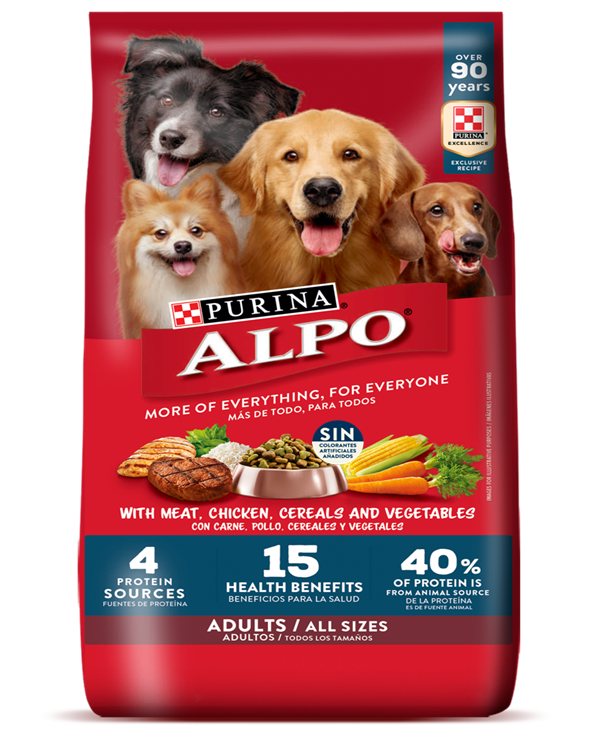Alpo Dog Food: Is It Good? A Complete Review & Guide
Is your dog's dinner bowl a battleground of picky eating? For decades, Alpo has stood as a steadfast, recognizable presence on pet store shelves, offering a wide array of dog food options meticulously formulated to meet the diverse dietary requirements and breed-specific needs of our canine companions. As responsible and loving pet owners, we're perpetually on the quest to furnish our furry family members with the absolute best nourishment possible, making it imperative to thoroughly understand the choices available to us.
In recent years, the demand for superior-quality dog food has skyrocketed, giving rise to a competitive landscape teeming with brands, each vying to claim the title of purveyor of optimum nutrition. Alpo distinguishes itself by delivering cost-effective yet nutritionally sound alternatives that resonate with a broad spectrum of dog owners. This in-depth examination will dissect the elements that contribute to Alpo's enduring popularity, while also presenting a balanced perspective by weighing its benefits against its potential drawbacks.
| Alpo Dog Food Brand Information | |
|---|---|
| Founded | 1936 |
| Founder | Robert E. Johnson |
| Type | Dog Food Brand |
| Headquarters | United States |
| Key Products | Canned Dog Food, Dry Dog Food, Dog Treats |
| Nutritional Focus | Balanced mix of proteins, fats, and carbohydrates, along with essential vitamins and minerals |
| Website | Purina - Alpo |
Whether you're a first-time dog owner navigating the vast world of canine nutrition or a seasoned pet parent contemplating a change in your dog's dietary regimen, this all-encompassing guide promises to illuminate every facet of Alpo, empowering you to make well-informed decisions that prioritize your beloved pet's health and overall well-being. After all, a happy dog starts with a healthy diet, and knowing your options is the first step toward achieving that.
- Alert Has Ramen Noodles Been Recalled Safety Guide Tips
- Urgent What You Need To Know About The Ramen Noodles Recall Now
Table of Contents
- 1. History of Alpo
- 2. Product Range
- 3. Ingredients Analysis
- 4. Nutritional Benefits
- 5. Customer Reviews and Feedback
- 6. Comparisons with Other Brands
- 7. Safety and Recall Information
- 8. Alpo: The Final Verdict
1. History of Alpo
The Alpo saga began in 1936, fueled by the vision of Robert E. Johnson, an entrepreneur with a desire to revolutionize dog food. Johnsons core principle was simple yet profound: to engineer a dog food product that was both highly nutritious and within reach for the average pet owner. The brand rapidly ascended in popularity, primarily owing to its canned dog food offerings. These were cleverly marketed as a comprehensive, all-in-one meal solution, eliminating the guesswork for dog owners. The essence of Alpo, from its inception, centered on practicality and affordability, a strategy that resonated deeply with the burgeoning pet-owning demographic of the time.
As the decades marched on, Alpo demonstrated its capacity to adapt and innovate. It strategically broadened its product portfolio to encompass not only canned food but also dry kibble, a variety of tempting treats designed to reward good behavior, and specialized formulations tailored to the diverse needs of different dog breeds and life stages. This expansion was not merely about adding more products; it reflected Alpos commitment to catering to the evolving understanding of canine nutritional science and the increasingly nuanced demands of pet owners. The brand recognized that puppies have different nutritional needs than senior dogs, and that certain breeds may be predisposed to specific dietary sensitivities. By offering specialized options, Alpo solidified its position as a reliable and adaptable player in the pet food market.
The growth of Alpo mirrors the evolution of the pet food industry itself. From humble beginnings focused on basic sustenance, the industry has transformed into a sophisticated arena where scientific research, marketing prowess, and consumer preferences intersect. Alpos long and storied history is a testament to its ability to navigate these changes, always striving to provide a balance of value and nutrition for dogs across America.
- Discover Karamo Browns Inspiring Life From Social Work To Queer Eye
- Is Ramen Virus Real The Truth About Ramen Safety Today
2. Product Range
Alpo's product range is characterized by its breadth and depth, ensuring that it addresses the multifarious dietary needs and individual preferences of dogs. The brand understands that dogs, much like humans, have distinct tastes and requirements, and its diverse product lines reflect this understanding. Here's an overview of some of Alpos flagship offerings:
- Alpo Chop House: This line of wet food distinguishes itself through the incorporation of hearty, visible cuts of meat, immersed in savory and aromatic sauces. Its designed to appeal to dogs who relish a more substantial and textured meal. The "Chop House" moniker evokes images of a high-end dining experience, subtly implying a level of quality and taste that sets it apart. The product line includes a variety of flavors and meat sources, ensuring that even the pickiest eaters can find something to enjoy.
- Alpo Variety Snaps: These crunchy treats are available in an array of enticing flavors, carefully engineered to maintain your dogs dental hygiene. The texture and composition of the snaps are designed to help scrape away plaque and tartar buildup, promoting healthier gums and teeth. This dual-purpose approach rewarding your dog while simultaneously caring for their oral health is a key selling point. The variety of flavors keeps things interesting for your dog, preventing boredom and encouraging engagement during training sessions.
- Alpo Dry Dog Food: Alpos dry dog food line is formulated with meticulous attention to detail, offering specialized options for puppies, adult dogs, and senior dogs. These formulas are designed to provide a balanced amalgamation of essential nutrients, catering to the unique developmental and maintenance needs of dogs at different stages of life. The puppy formula, for example, is typically enriched with higher levels of protein and calcium to support rapid growth and bone development. The senior formula, on the other hand, may contain added glucosamine and chondroitin to promote joint health and mobility.
The strategic segmentation of Alpos dry dog food line underscores the brands commitment to providing age-appropriate nutrition. This attention to detail reassures pet owners that they are providing the right balance of nutrients to support their dogs health and vitality at every stage of life.
2.1. Specialty Formulas
Recognizing that some dogs have unique dietary needs, Alpo has developed specialty formulas designed to address specific health concerns. These formulas cater to dogs struggling with weight management and those with sensitive stomachs. The weight management formulas are typically lower in calories and fat, helping dogs achieve and maintain a healthy weight without sacrificing essential nutrients. The sensitive stomach formulas, on the other hand, are formulated with easily digestible ingredients and often exclude common allergens such as wheat, corn, and soy. By offering these specialty options, Alpo demonstrates its commitment to inclusivity and providing solutions for dogs with a wide range of dietary needs. This willingness to adapt and cater to specific health concerns helps build trust and loyalty among pet owners.
3. Ingredients Analysis
The quality of ingredients stands as a cornerstone in the selection of any dog food. Alpo emphasizes the utilization of real meat as a primary component in many of its formulations. However, a discerning approach necessitates a more in-depth examination that goes beyond mere meat content. A comprehensive understanding of the ingredient list is paramount to making an informed and responsible choice for your pet. Heres a breakdown of key ingredient categories that warrant careful consideration:
- Meat by-products: While often a source of protein, the term "meat by-products" can be vague and encompasses a wide range of ingredients. Some pet owners are wary of by-products, preferring to see named meat sources (e.g., chicken, beef, lamb) listed prominently on the ingredient list. The quality and source of by-products can vary, and transparency is key to making an informed decision.
- Grains such as corn and wheat: These grains are frequently used as fillers in dog food and can be a source of carbohydrates. However, some dogs are sensitive or allergic to corn and wheat, leading to digestive issues or skin problems. Grain-free alternatives are available for dogs with these sensitivities. The nutritional value of corn and wheat is also a subject of debate, with some arguing that they provide limited benefits compared to other carbohydrate sources like sweet potatoes or brown rice.
- Additives for flavor and preservation: Dog food often contains additives to enhance flavor and extend shelf life. While some additives are harmless, others may be controversial. Artificial colors, flavors, and preservatives are often viewed with suspicion by health-conscious pet owners. Natural alternatives, such as vitamin E (tocopherols) and rosemary extract, are often preferred as preservatives.
While Alpo incorporates meat into its formulations, a segment of dog owners expresses a preference for brands that prioritize higher-quality, whole-food ingredients. These ingredients may include named meat sources, whole grains, fruits, and vegetables. The decision ultimately hinges on a variety of factors, including budget, individual dog needs, and personal preferences. Understanding the nuances of the ingredient list empowers you to make a choice that aligns with your values and your dogs specific dietary requirements.
4. Nutritional Benefits
Alpo prides itself on formulating products that align with the nutritional requirements of dogs across various life stages. The brand emphasizes a balanced composition of proteins, fats, and carbohydrates, supplemented with essential vitamins and minerals. However, its crucial to delve deeper into the specific benefits that Alpo aims to provide:
- High protein content from real meat: Protein is vital for muscle development, tissue repair, and overall health. Alpo highlights the inclusion of real meat as a primary source of protein in many of its products. However, the quantity and quality of the meat used can vary. Its important to examine the ingredient list to determine the specific meat sources and their position relative to other ingredients.
- Rich in essential fatty acids for healthy skin and coat: Fatty acids, such as omega-3 and omega-6, play a crucial role in maintaining healthy skin and a shiny coat. Alpo claims to include these essential fatty acids in its formulations. The sources of these fatty acids can vary, with some brands using fish oil, flaxseed, or other plant-based sources.
- Fortified with vitamins and minerals to support overall health: Vitamins and minerals are essential for a wide range of bodily functions, including immune system support, bone health, and energy production. Alpo claims to fortify its products with these essential nutrients. However, the specific vitamins and minerals included, as well as their levels, can vary.
While Alpo touts these nutritional benefits, it's important to remember that every dog is unique and has individual dietary needs. Consulting with your veterinarian is crucial to determine the specific nutritional requirements of your dog and whether Alpo aligns with those needs. A veterinarian can assess your dog's health, weight, activity level, and any specific dietary sensitivities to provide personalized recommendations.
5. Customer Reviews and Feedback
Customer reviews serve as a valuable gauge for assessing the efficacy and overall satisfaction associated with any dog food brand. Alpo elicits a spectrum of opinions from pet owners. A significant number commend Alpo for its affordability and palatability, emphasizing that their dogs readily consume it. Conversely, some customers voice concerns regarding the quality of ingredients, particularly the inclusion of by-products and fillers. Here's a closer look at the prevailing sentiments expressed by Alpo customers:
- Positive: Dogs love the taste and readily eat it: This is a consistent theme in positive reviews. Many pet owners report that their dogs are enthusiastic about Alpo, even if they are typically picky eaters. Palatability is a crucial factor for many dog owners, as it ensures that their dogs are actually consuming the food and receiving the necessary nutrients.
- Negative: Concerns about the inclusion of by-products and fillers: This is a common criticism of Alpo. Some pet owners are concerned about the use of meat by-products, corn, and wheat, preferring brands that use higher-quality, whole-food ingredients. These concerns often stem from a desire to provide their dogs with the best possible nutrition and avoid potential allergens or digestive issues.
The dichotomy in customer feedback underscores the importance of considering individual priorities and values when choosing a dog food. While Alpo may be a suitable option for some dogs and pet owners, it may not be the best choice for others. Reading a diverse range of reviews can provide valuable insights into the potential benefits and drawbacks of Alpo, helping you make a more informed decision.
6. Comparisons with Other Brands
When embarking on a comparative analysis of Alpo and other dog food brands, it becomes imperative to weigh pivotal factors such as ingredient quality, nutritional content, and pricing. Alpo occupies a niche as a more budget-friendly alternative; however, its essential to acknowledge that premium brands often offer a higher caliber of ingredients. The ultimate decision should be predicated on your dog's unique needs and dietary sensitivities, as well as your personal preferences and financial considerations.
Heres a framework for comparing Alpo with other brands:
- Ingredient Quality: Scrutinize the ingredient lists of Alpo and its competitors. Pay close attention to the prominence of named meat sources, the presence of by-products, the types of grains used, and the inclusion of artificial additives. Brands that prioritize whole-food ingredients and avoid controversial additives are generally considered to be of higher quality.
- Nutritional Content: Compare the guaranteed analysis of Alpo and its competitors. Focus on the levels of protein, fat, fiber, and moisture. Consider the specific needs of your dog when evaluating these numbers. For example, a highly active dog may require a food with a higher protein and fat content.
- Price: Alpo is typically positioned as a more affordable option. However, its important to consider the price per serving, rather than just the price per bag. A higher-quality food may be more expensive per bag, but it may also be more nutrient-dense, meaning you can feed your dog less.
Ultimately, the best way to compare Alpo with other brands is to do your research, read reviews, and consult with your veterinarian. Your veterinarian can provide personalized recommendations based on your dogs individual needs and health status.
7. Safety and Recall Information
Like numerous brands within the pet food sector, Alpo has experienced recalls attributable to potential contamination issues. Staying informed regarding any recalls and verifying the safety of the products you purchase is crucial for consumers. The best course of action is to consistently consult the brand's official website for the most up-to-date information.
Heres how to stay informed about Alpo recalls:
- Check the FDA website: The Food and Drug Administration (FDA) maintains a database of pet food recalls. You can search this database to see if Alpo has been subject to any recalls.
- Visit the Alpo website: Alpo typically posts recall information on its website.
- Sign up for email alerts: Several websites offer email alerts for pet food recalls.
If you suspect that your dog has been affected by a recalled pet food, contact your veterinarian immediately. Common symptoms of foodborne illness in dogs include vomiting, diarrhea, lethargy, and loss of appetite. Prompt veterinary care can help prevent serious complications.
8. Alpo
In summation, Alpo has cemented its status as a popular choice among dog owners, primarily driven by its affordability and extensive product selection. Although it may not represent the zenith of quality within the dog food landscape, it strikes a delicate equilibrium between taste and nutritional value for many canine companions. It's essential to carefully evaluate your pet's specific requirements and seek counsel from your veterinarian to ascertain whether Alpo aligns with their needs. The decision hinges on a comprehensive understanding of the brand's ingredients, nutritional content, and potential drawbacks, as well as your dog's individual health status and dietary sensitivities. Ultimately, the goal is to provide your dog with a food that supports their overall health, vitality, and happiness.
- Urgent Cdc Issues Ramen Noodles Recall What You Need To Know
- Alert Ramen Noodle Recalls Safety Tips You Need To Know

Purina Alpo® Adult Meat & Vegetables Purina Express

Alpo (big time drug dealer)... Chrissy from "love and hip hop" ex

Alpo Martinez was killed over a minor traffic incident, police say